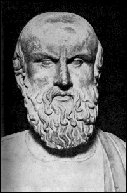

Xerxes, the cruel and despotic
King of the Persians had assembled a vast army,
supported by a great armada, and forced them across the Hellespont under the lash.
He had marched them through Thrace and Macedonia,
had defeated the Spartans at Thermopylae, the inner gateway to Hellas, and slain King Leonidas.
First Locris, and then Phocis and Boeotia had fallen
under the Persian yoke. The plight of the Hellenes was desperate: they
had abandoned Athens, leaving behind only a token garrison to defend the Acropolis
to the death. Indeed, they had
abandoned the whole of Attica, and withdrawn the fleet to the island of Salamis.....
DATELINE 17 SEPTEMBER
Athens has fallen. The temples of the Acropolis have been looted and burnt,
its garrison slain. The Greek commanders hold a council of war, at which
Themistocles,
master tactician, persuades them to fight - what they expect to be their
last battle - in Salaminian waters, rather than in the open sea. This is a brave and a bold resolution,
for at Salamis the fleet will be entirely cut off, with no possibility of retreat.
Truly, it is a last throw of the dice.....
DATELINE 20 SEPTEMBER.
Persuaded by false intelligence that the Athenians are prepared to turn
against their allies, Xerxes decides to attack at dawn. A fatal error.
As the Persian columns edge into the sound, the Athenians fall suddenly and savagely
upon their flank
and drive them towards the Attic shore. The superior numbers and speed
of the Persian ships count for nothing in those narrow waters, barely a mile wide.
By nightfall little remains of the proud armada of Xerxes, and the Persian soldiers
stationed on Psyttalea have been slaughtered.
Given the special place that Salamis thus occupied in the Greek mind,
you can be sure that even the most casual reference in later writings
to a sea-battle would be guaranteed to tug the audience back to the iconic moment.
Aristotle, writing more than a hundred years later,
uses the device repeatedly. In De Interpretatione 9 he twice mentions a sea-battle
in the course of making a minor intellectual point. Have a look, if you like.
I am sure he does it quite deliberately. His point concerns chance, necessity,
and the future.
And Salamis is ideal for his pedagogic purpose, for his readers would know so well
that no necessity attached to any of the events of those days,
that all came about as chance has it, thanks to the perspicacity of Themistocles and
the bravery of his men.
J.B.Bury and Russell Meiggs, A History of Greece,
4th edition (with corrections and revisions), MacMillan, London 1979
Military matters.....
 DATELINE 19 SEPTEMBER.
The Allied fleet is trapped.
It is anchored in the shelter of the long promontory
which runs out into the narrow sound between Salamis and mainland Attica.
The island of Psyttalea divides that sound,
with an Ionian squadron guarding the left channel,
and the Phoenician fleet - the bulk of the Persian armada -
guarding the right.
Nor is there any escape to the open sea west of Salamis:
an Egyptian squadron lies in wait.
DATELINE 19 SEPTEMBER.
The Allied fleet is trapped.
It is anchored in the shelter of the long promontory
which runs out into the narrow sound between Salamis and mainland Attica.
The island of Psyttalea divides that sound,
with an Ionian squadron guarding the left channel,
and the Phoenician fleet - the bulk of the Persian armada -
guarding the right.
Nor is there any escape to the open sea west of Salamis:
an Egyptian squadron lies in wait.
And on the mainland of Attica, cruel Xerxes waits and watches
from a high throne on the slopes of Mount Aegaleos.....
Cultural matters.....
 The effect of Salamis on Hellenistic art,
and thus on the very foundation of Western culture, is massive.
The iconicity of the moment - the triumph of Greek over barbarian - inspired the Greeks
to an outpouring of artistic endeavour.
The effect of Salamis on Hellenistic art,
and thus on the very foundation of Western culture, is massive.
The iconicity of the moment - the triumph of Greek over barbarian - inspired the Greeks
to an outpouring of artistic endeavour.
Herodotus
the story-teller (pictured on your left),
 Father of Greek History and
four years old at the time, created the myth.
The Poets embellished and celebrated that myth as they sang of artful Themistocles and brave Aristides.
Father of Greek History and
four years old at the time, created the myth.
The Poets embellished and celebrated that myth as they sang of artful Themistocles and brave Aristides.
Aeschylus (pictured to your right), the Father of Greek Tragedy,
fought at Salamis alongside his brother at the age of 45.
He was one of the band of hoplites led by Aristides
which retook Psyttalea
and slew the occupying Persians. Eight years later, he wove his experiences into his second
(extant) drama, The Persians, which recounts
the story of the battle as it is received at the imperial court.
Sculptors
recorded scenes from Salamis in temple friezes from one end of Hellas to the other.
And art galleries in modern Greece are piled high with
paintings depicting the battle, some of them reproduced here....
And now, some Philosophy.....
To find out more.....